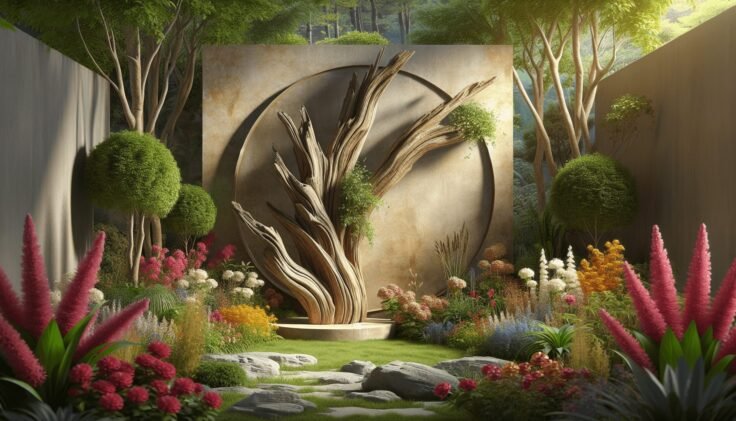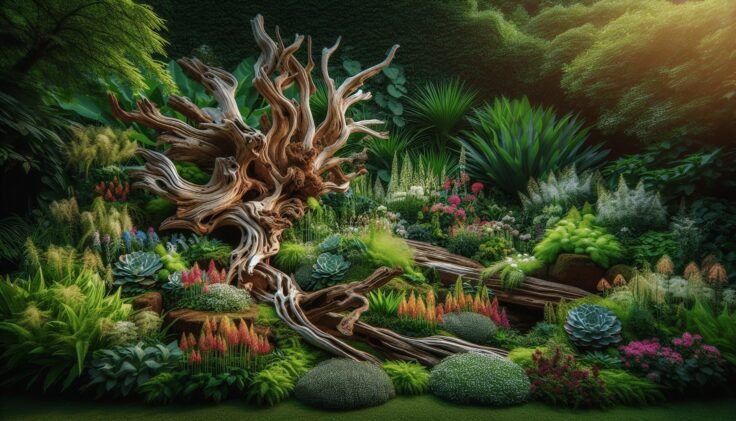Have you ever strolled along the beach, noticing the intricate shapes and unique textures of driftwood and wondered how you could incorporate it into your garden? Driftwood holds a natural charm and brings an organic, artistic touch to any outdoor space. Whether you have a sprawling yard or a cozy balcony, there are countless creative and practical ways to use driftwood in your garden.

Understanding Driftwood
Driftwood refers to pieces of wood that have been washed onto the shore of a sea, river, or lake by the action of winds, tides, or waves. This type of wood has a unique, weathered appearance and can vary greatly in size, shape, and color. It’s loved by artists and nature enthusiasts alike for its rustic, timeless appeal.
Why Use Driftwood in Your Garden?
Incorporating driftwood into your garden has both aesthetic and environmental benefits. Not only does it bring a touch of natural beauty to your space, but it’s also a sustainable and eco-friendly choice. Reusing driftwood means you’re recycling a natural resource, aiding in reducing waste and promoting environmental conservation.
Preparing Driftwood for Garden Use
Before showcasing pieces of driftwood in your garden, it’s important to prepare them properly. This ensures the wood lasts longer and doesn’t introduce any unwanted pests to your garden.
Cleaning Driftwood
The first step in preparing driftwood is cleaning it thoroughly. Begin by using a stiff brush to remove any sand and debris. If you’re concerned about insects or salt, soaking the wood in a mixture of water and a little bleach for a day can be beneficial. Rinse it well afterward and let it dry completely in the sun.
Preserving Driftwood
Though driftwood is naturally resilient, applying a sealant or wood preservative can protect it from the elements, enabling it to last longer in your garden. Choose a product that’s non-toxic, especially if it will be near plants or animals. Apply the sealant with a brush and let it dry fully before placing the driftwood in your garden.
Creative Driftwood Ideas for Your Garden
Driftwood can be used in myriad ways to add both beauty and utility to your outdoor environs. From planters to pathways, there are numerous possibilities. Here are some creative ideas to get you started.
Driftwood Planters
One popular way to use driftwood is as planters. Depending on the size and shape of your driftwood pieces, they can be transformed into unique containers for succulents, small flowers, or ferns.
How to Make a Driftwood Planter
- Select Your Driftwood: Choose pieces that have a natural hollow or could be easily hollowed out.
- Prepare the Wood: Clean and seal the driftwood, as described above, to ensure longevity.
- Create a Planting Space: Use a chisel or drill to make a recess in the wood, deep enough to hold soil and plant roots.
- Add Soil and Plants: Fill the hollow with a well-draining soil mix suitable for your plant choice, then plant your succulents or small flowers.
Driftwood Pathways
Driftwood can also be used to create enchanting garden pathways. Lay longer, flat pieces along your garden to form stepping stones or combine smaller pieces for a more intricate design.
Designing a Driftwood Pathway
- Plan the Layout: Decide where your pathway will go and experiment with different driftwood arrangements.
- Level the Ground: Ensure the ground is even before placing the wood. This will prevent wobbling.
- Secure the Wood: Use landscape fabric and gravel underneath to secure the driftwood and promote drainage.
Building Driftwood Structures
If you’ve gathered larger pieces, consider building structures like garden arches or trellises. These can become focal points in your garden while providing support for climbing plants.
Steps to Building a Driftwood Structure
- Design Your Structure: Sketch out your desired garden feature.
- Gather Materials: Besides driftwood, you may need nails, screws, or natural twine.
- Assemble the Structure: Secure pieces together, ensuring stability.
Using Driftwood as Decorative Elements
Sometimes, the best way to feature driftwood in your garden is by showcasing it as a standalone piece or simple decorative element.
Driftwood Sculptures
Natural patterns in driftwood make it an ideal candidate for garden sculptures. You can position it as a striking centerpiece or integrate smaller pieces throughout your garden.
Creating Driftwood Art
Turning driftwood into garden art can be as simple or as complex as you like. You can leave pieces as they are, appreciating their natural beauty, or get creative by painting or carving them.
Hanging Driftwood Decorations
For an elevated touch, consider hanging driftwood from trees or pergolas. Wind chimes made from smaller pieces of driftwood add not only visual interest but also a gentle, melodic sound to your garden ambiance.

Driftwood and Garden Wildlife
Not only humans appreciate the aesthetic of driftwood; local wildlife does too. By incorporating driftwood into your garden, you provide habitat opportunities for various insects and birds.
Driftwood as Habitat
Birds might use larger pieces as perches, while insects and small animals could find refuge in and around the wood. Place driftwood strategically to support both beauty and biodiversity.
Encouraging Biodiversity
Driftwood installations can become mini ecosystems within your garden. You may notice new species visiting, contributing to a more vibrant and balanced garden environment.
Considerations When Using Driftwood
When utilizing driftwood, there are a few considerations to keep in mind to ensure your garden remains beautiful, safe, and environmentally friendly.
Sourcing Driftwood Responsibly
It’s important to remember that driftwood is part of a coastal or lakeside ecosystem. Collect driftwood from designated areas where collecting is permitted and always be mindful of the environmental impact.
Balance and Contrast
While driftwood can add a remarkable element of natural beauty, it’s essential to balance its use. Too much can overwhelm your garden, so think about how driftwood complements your existing plants and landscape design.
Maintenance and Care
Driftwood requires minimal maintenance. However, depending on the climate, you might need to reapply sealants annually or reposition pieces to best display their unique features as the garden evolves.
Conclusion
Incorporating driftwood into your garden offers a fantastic opportunity to add character and ecological value to your outdoor space. From dreamy pathways to lively planters and artistic sculptures, driftwood’s versatility can transform any garden area into a place of tranquility and aesthetic delight. By preparing and arranging these unique pieces thoughtfully, you can craft a magical environment that enhances the natural beauty around you while fostering a closer connection to the natural world. So, why not give driftwood a chance to breathe new life into your garden?